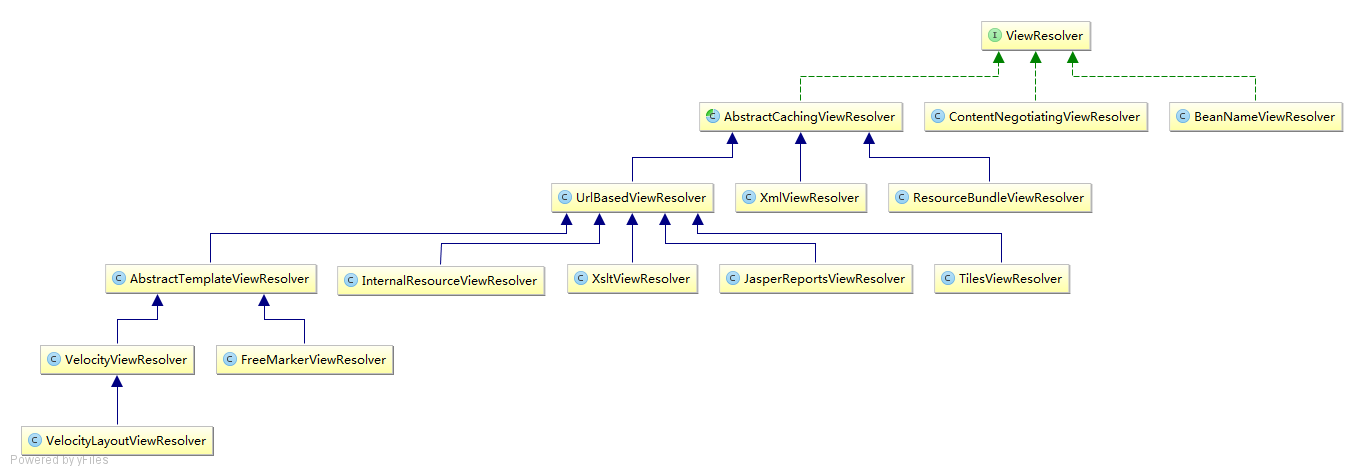SpringMVC源码分析(8)剖析ViewResolver
View视图 其实就是对应MVC中的"V"
1.ViewResolver 结构图

2.BeanNameViewResolver
通过把返回的逻辑视图名称去匹配定义好的视图bean对象。
|
1
2
3
4
5
6
7
8
9
10
11
12
13
14
15
|
@Test
public void testBeanNameViewResolver() throws ServletException {
StaticWebApplicationContext wac = new StaticWebApplicationContext();
wac.setServletContext(new MockServletContext());
MutablePropertyValues pvs1 = new MutablePropertyValues();
pvs1.addPropertyValue(new PropertyValue("url", "/example1.jsp"));
wac.registerSingleton("example1", InternalResourceView.class, pvs1);
BeanNameViewResolver vr = new BeanNameViewResolver();
vr.setApplicationContext(wac);
wac.refresh();
View view = vr.resolveViewName("example1", Locale.getDefault());
assertEquals("Correct view class", InternalResourceView.class, view.getClass());
assertEquals("Correct URL", "/example1.jsp", ((InternalResourceView) view).getUrl());
}
|
3.XmlViewResolver
XmlViewResolver这个视图解析器跟 BeanNameViewResolver 有点类似,也是通过把返回的逻辑视图名称去匹配定义好的视图 bean 对象。
3.1 配置XML
|
1
2
3
4
5
6
7
8
9
10
11
12
13
14
15
|
<?xml version="1.0" encoding="UTF-8"?>
<!DOCTYPE beans PUBLIC "-//SPRING//DTD BEAN 2.0//EN" "http://www.springframework.org/dtd/spring-beans-2.0.dtd">
<beans>
<bean id="example1" class="org.springframework.web.servlet.view.ViewResolverTests$TestView">
<property name="url"><value>/example1.jsp</value></property>
<property name="attributesMap">
<map>
<entry key="test1"><value>testvalue1</value></entry>
<entry key="test2"><ref bean="testBean"/></entry>
</map>
</property>
<property name="location"><value>test</value></property>
</bean>
</beans>
|
3.2 测试用例
|
1
2
3
4
5
6
7
8
9
10
11
12
13
14
|
@Test
public void testXmlViewResolver() throws Exception {
StaticWebApplicationContext wac = new StaticWebApplicationContext();
wac.registerSingleton("testBean", TestBean.class);
wac.setServletContext(new MockServletContext());
wac.refresh();
TestBean testBean = (TestBean) wac.getBean("testBean");
XmlViewResolver vr = new XmlViewResolver();
vr.setLocation(new ClassPathResource("org/springframework/web/servlet/view/views.xml"));
vr.setApplicationContext(wac);
View view1 = vr.resolveViewName("example1", Locale.getDefault());
assertTrue("Correct view class", TestView.class.equals(view1.getClass()));
assertTrue("Correct URL", "/example1.jsp".equals(((InternalResourceView) view1).getUrl()));
|
BeanNameViewResolver VS XmlViewResolver
1. BeanNameViewResolver 要求视图 bean 对象都定义在 Spring 的 application context 中,而 XmlViewResolver 是在指定的配置文件中寻找视图 bean 对象,
2. XmlViewResolver是 AbstractCachingViewResolver的子类,支持缓存;
BeanNameViewResolver 不会进行视图缓存。
4. ResourceBundleViewResolver
和 XmlViewResolver 一样它也需要有一个配置文件来定义逻辑视图名称和真正的 View 对象的对应关系,不同的是 ResourceBundleViewResolver 的配置文件是一个属性文件,而且必须是放在 classpath 路径下面的,默认情况下这个配置文件是在 classpath 根目录下的 views.properties 文件,如果不使用默认值的话,则可以通过属性 baseName 或 baseNames 来指定。
4.1 配置文件testviews_fr.properties
|
1
2
3
|
debugView.(class)= org.springframework.web.servlet.view.InternalResourceView
debugView.url=jsp/debug/deboug.jsp
debugView.contentType=text/xml;charset=ISO-8859-1
|
4.2 测试用例
|
1
2
3
4
5
6
7
8
9
10
11
12
13
14
15
16
17
18
19
20
21
22
23
24
25
26
27
28
29
30
31
|
public class ResourceBundleViewResolverTests extends TestCase {
/** Comes from this package */
private static String PROPS_FILE = "org.springframework.web.servlet.view.testviews";
private ResourceBundleViewResolver rb;
private StaticWebApplicationContext wac;
protected void setUp() throws Exception {
rb = new ResourceBundleViewResolver();
rb.setBasename(PROPS_FILE);
rb.setCache(getCache());
rb.setDefaultParentView("testParent");
wac = new StaticWebApplicationContext();
wac.setServletContext(new MockServletContext());
wac.refresh();
// This will be propagated to views, so we need it.
rb.setApplicationContext(wac);
}
public void testDebugViewFrench() throws Exception {
View v = rb.resolveViewName("debugView", Locale.FRENCH);
assertTrue("French debugView must be of type InternalResourceView", v instanceof InternalResourceView);
InternalResourceView jv = (InternalResourceView) v;
assertTrue("French debugView must have correct URL", "jsp/debug/deboug.jsp".equals(jv.getUrl()));
assertTrue(
"Correct overridden (XML) content type, not '" + jv.getContentType() + "'",
jv.getContentType().equals("text/xml;charset=ISO-8859-1"));
}
}
|
在ResourceBundleViewResolver第一次进行视图解析的时候会先new一个BeanFactory对象,然后把properties文件中定义好的属性按照它自身的规则生成一个个的bean对象注册到该BeanFactory中,之后会把该BeanFactory对象保存起来,所以ResourceBundleViewResolver缓存的是BeanFactory,而不是直接的缓存从BeanFactory中取出的视图bean。然后会从bean工厂中取出名称为逻辑视图名称的视图bean进行返回。接下来就讲讲Spring通过properties文件生成bean的规则。它会把properties文件中定义的属性名称按最后一个点“.”进行分割,把点前面的内容当做是bean名称,点后面的内容当做是bean的属性。这其中有几个特别的属性,Spring把它们用小括号包起来了,这些特殊的属性一般是对应的attribute,但不是bean对象所有的attribute都可以这样用。其中(class)是一个,除了(class)之外,还有(scope)、(parent)、(abstract)、(lazy-init)。而除了这些特殊的属性之外的其他属性,Spring会把它们当做bean对象的一般属性进行处理,就是bean对象对应的property。所以根据上面的属性配置文件将生成如下两个bean对象:
from http://elim.iteye.com/blog/1770554
5.UrlBasedViewResolver
它是对ViewResolver的一种简单实现,而且继承了AbstractCachingViewResolver,主要就是提供的一种拼接URL的方式来解析视图,它可以让我们通过prefix属性指定一个指定的前缀,通过suffix属性指定一个指定的后缀,然后把返回的逻辑视图名称加上指定的前缀和后缀就是指定的视图URL了。

5.2 重要属性
|
1
2
3
4
5
6
7
8
9
10
11
12
13
14
15
16
17
18
19
20
21
22
23
24
25
26
27
28
29
30
31
32
33
34
35
36
37
38
39
40
41
42
|
public class UrlBasedViewResolver extends AbstractCachingViewResolver implements Ordered {
/**
* Prefix for special view names that specify a redirect URL (usually
* to a controller after a form has been submitted and processed).
* Such view names will not be resolved in the configured default
* way but rather be treated as special shortcut.
*/
public static final String REDIRECT_URL_PREFIX = "redirect:";
/**
* Prefix for special view names that specify a forward URL (usually
* to a controller after a form has been submitted and processed).
* Such view names will not be resolved in the configured default
* way but rather be treated as special shortcut.
*/
public static final String FORWARD_URL_PREFIX = "forward:";
//Set the view class that should be used to create views.
private Class viewClass;
// Set the prefix that gets prepended to view names when building a URL.
private String prefix = "";
//the suffix that gets appended to view names when building a URL.
private String suffix = "";
//view names; such that 'my*', '*Report' and '*Repo*'
private String[] viewNames = null;
//content type for all views.
private String contentType;
//UrlBasedViewResolver 的 redirectContextRelative 的默认值为 true,
//这意味着,只要重定向的资源以/开头,那么 spring 会帮你添加 contextPath
private boolean redirectContextRelative = true;
//whether redirects should stay compatible with HTTP 1.0 clients
private boolean redirectHttp10Compatible = true;
//the name of the RequestContext attribute for all views
private String requestContextAttribute;
private int order = Integer.MAX_VALUE;
/** Map of static attributes, keyed by attribute name (String) */
private final Map<String, Object> staticAttributes = new HashMap<String, Object>();
...
}
|
5.3 createView方法
|
1
2
3
4
5
6
7
8
9
10
11
12
13
14
15
16
17
18
19
20
|
public static final String REDIRECT_URL_PREFIX = "redirect:";
protected View createView(String viewName, Locale locale) throws Exception {
// If this resolver is not supposed to handle the given view,
// return null to pass on to the next resolver in the chain.
if (!canHandle(viewName, locale)) {
return null;
}
// Check for special "redirect:" prefix.
if (viewName.startsWith(REDIRECT_URL_PREFIX)) {
String redirectUrl = viewName.substring(REDIRECT_URL_PREFIX.length());
return new RedirectView(redirectUrl, isRedirectContextRelative(), isRedirectHttp10Compatible());
}
// Check for special "forward:" prefix.
if (viewName.startsWith(FORWARD_URL_PREFIX)) {
String forwardUrl = viewName.substring(FORWARD_URL_PREFIX.length());
return new InternalResourceView(forwardUrl);
}
// Else fall back to superclass implementation: calling loadView.
return super.createView(viewName, locale);
}
|
URLBasedViewResolver发现返回的视图名称包含”redirect:”前缀,于是把返回的视图名称前缀”redirect:”去掉,取后面的test.do组成一个RedirectView,RedirectView中将把请求返回的模型属性组合成查询参数的形式组合到redirect的URL后面,然后调用HttpServletResponse对象的sendRedirect方法进行重定向。同样URLBasedViewResolver还支持forword:前缀,对于视图名称中包含forword:前缀的视图名称将会被封装成一个InternalResourceView对象,然后在服务器端利用RequestDispatcher的forword方式跳转到指定的地址。使用UrlBasedViewResolver的时候必须指定属性viewClass,表示解析成哪种视图,一般使用较多的就是InternalResourceView,利用它来展现jsp,但是当我们使用JSTL的时候我们必须使用JstlView。
5.4 一段UrlBasedViewResolver的定义
|
1
2
3
4
5
6
|
<bean
class="org.springframework.web.servlet.view.UrlBasedViewResolver">
<property name="prefix" value="/WEB-INF/" />
<property name="suffix" value=".jsp" />
<property name="viewClass" value="org.springframework.web.servlet.view.InternalResourceView"/>
</bean>
|
6.InternalResourceViewResolver 内部资源视图解析器
InternalResourceViewResolver会把返回的视图名称都解析为InternalResourceView对象,InternalResourceView会把Controller处理器方法返回的模型属性都存放到对应的request属性中,然后通过RequestDispatcher在服务器端把请求forword重定向到目标URL。
6.1最熟悉的一段配置
|
1
2
3
4
|
<bean class="org.springframework.web.servlet.view.InternalResourceViewResolver">
<property name="prefix" value="/WEB-INF/"/>
<property name="suffix" value=".jsp"></property>
</bean>
|
总结
ViewResolver解决的事情很单一
通过配置,根据不同策略,找出匹配的JSP(也可以是其他)。
适当添加缓存处理
根据策略不同,返回不同的VIEW,降低耦合度。
SpringMVC源码分析(8)剖析ViewResolver相关推荐
- SpringMVC源码分析(4)剖析DispatcherServlet重要组件
简单介绍了一个请求的处理过程, 简略描述了调用过程,并没有涉及过多细节,如url匹配,报文解析转换等. <SpringMVC源码分析(2)DispatcherServlet的初始化>:介绍 ...
- 简单直接让你也读懂springmvc源码分析(3.1)-- HandlerMethodReturnValueHandler
该源码分析系列文章分如下章节: springmvc源码分析(1)-- DispatcherServlet springmvc源码分析(2)-- HandlerMapping springmvc源码分析 ...
- SpringMVC源码分析_1 SpringMVC容器启动和加载原理
SpringMVC源码分析_1 SpringMVC启动和加载原理 ...
- springMVC源码分析--访问请求执行ServletInvocableHandlerMethod和InvocableHandlerMethod
在之前一篇博客中 springMVC源码分析--RequestMappingHandlerAdapter(五)我们已经简单的介绍到具体请求访问的执行某个Controller中的方法是在RequestM ...
- SpringMVC源码分析_框架原理图
SpringMVC源码分析_框架原理图 ...
- SpringMVC源码分析系列[转]
说到java的mvc框架,struts2和springmvc想必大家都知道,struts2的设计基本上完全脱离了Servlet容器,而springmvc是依托着Servlet容器元素来设计的,同时sp ...
- SpringMVC源码分析系列
说到java的mvc框架,struts2和springmvc想必大家都知道,struts2的设计基本上完全脱离了Servlet容器,而springmvc是依托着Servlet容器元素来设计的,同时sp ...
- Springmvc源码分析、底层原理
1.Springmvc是如何找到Controller的? 首先在请求过来时,会先进入DispatcherServlet进行请求分发,执行DispatcherServlet类中的doDispatch() ...
- SpringMVC源码分析(二)
1.DispatcherServlet源码分析 1.@InitBinder(续) 1.DataBinder概述 package org.springframework.validation; 此类所在 ...
- ZooKeeper面试题(2020最新版,springmvc源码分析pdf百度云
10. ACL 权限控制机制 UGO(User/Group/Others) 目前在 Linux/Unix 文件系统中使用,也是使用最广泛的权限控制方式.是一种粗粒度的文件系统权限控制模式. ACL(A ...
最新文章
- rfc6455 WebSockets
- 这次是真的!波士顿动力Atlas机器人又进化了,自主导航get新技能
- 失败 安装scikit_scikit-learn0.22版本最新发布
- 通过PEB获取模块基址
- mrc20温控f1什么意思_温控器的“总、高、低”是什么意思?不知道?民熔老电工告诉你...
- 使用RemObjects Pascal Script
- ASP.NET与MVC架构区别总结
- 计算机桌面组成部分教案,三年级信息技术第五课设置个性桌面教学设计
- Linux宝库快讯 | OpenInfra中国日正式确定会议合作方
- SQL语句优化常见方法
- 大学生创新创业计划-2019
- 设计一个巴特沃斯低通滤波器
- vue的事件修饰符之.prevent
- 新站长建设网站需要学习知识
- 百面机器学习 之 集成学习
- 织梦联动枚举字段添加一级分类如果超过132个自动变成二级解决方法
- 编程计算2×3阶矩阵A和3×2阶矩阵B之积C。矩阵相乘的基本方法是:矩阵A的第i行的所有元素同矩阵B第j列的所有元素对应相乘,并把相乘的结果相加,最终得到的值就是矩阵C的第i行第j列的值。
- ttkefu怎么取消英文版?显示中文版
- 复杂网络实验报告2019210025曾培圣
- python中定义变量有引号和单引号_说说Python 单引号、双引号、三引号的区别?...
